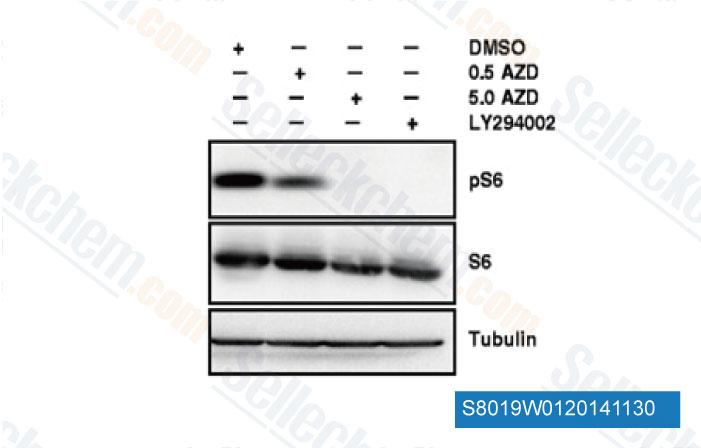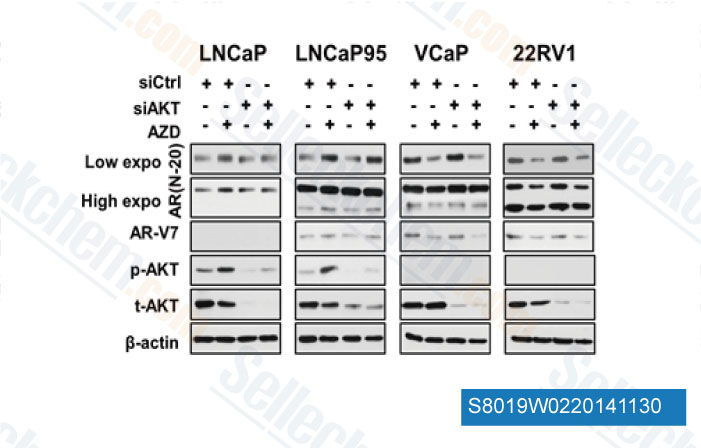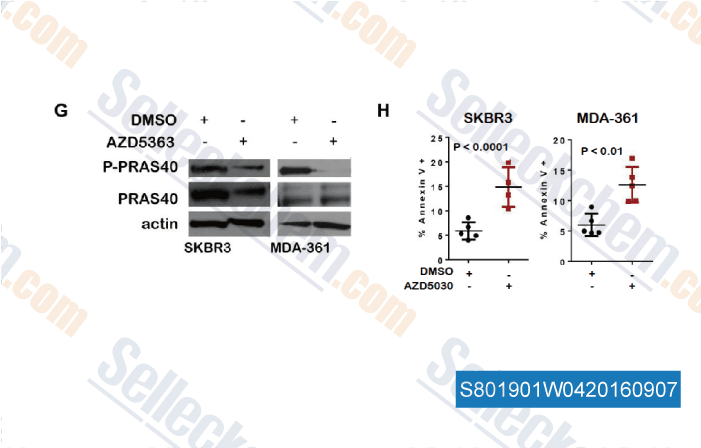|
Toll Free: (877) 796-6397 -- USA and Canada only -- |
Fax: +1-832-582-8590 Orders: +1-832-582-8158 |
Tech Support: +1-832-582-8158 Ext:3 Please provide your Order Number in the email. |
Technical Data
| Formula | C21H25ClN6O2 |
|||
| Molecular Weight | 428.92 | CAS No. | 1143532-39-1 | |
| Solubility (25°C)* | In vitro | DMSO | 88 mg/mL (205.16 mM) | |
| Ethanol | 29 mg/mL (67.61 mM) | |||
| Water | Insoluble | |||
|
* <1 mg/ml means slightly soluble or insoluble. * Please note that Selleck tests the solubility of all compounds in-house, and the actual solubility may differ slightly from published values. This is normal and is due to slight batch-to-batch variations. * Room temperature shipping (Stability testing shows this product can be shipped without any cooling measures.) |
||||
Preparing Stock Solutions
Biological Activity
| Description | Capivasertib (AZD5363) potently inhibits all isoforms of Akt(Akt1/Akt2/Akt3) with IC50 of 3 nM/8 nM/8 nM in cell-free assays, similar to P70S6K/PKA and lower activity towards ROCK1/2. Phase 2. | ||||||||
|---|---|---|---|---|---|---|---|---|---|
| Targets |
|
||||||||
| In vitro | AZD5363 is a potent Akt inhibitor with IC50 of 3 nM, 8 nM and 8 nM for Akt1, Akt2 and Akt3, respectively. [1] AZD5363 inhibits phosphorylation of AKT substrates in cells with a potency of approximately 0.3 to 0.8 μM. AZD5363 inhibits the proliferation of 41 of 182 solid and hematologic tumor cell lines with a potency of < 3 μM. [2] Activating mutations in PIK3CA, loss or inactivation of tumor suppressor PTEN, or HER2 amplification all are significantly predictive of responsiveness to AZD5363. Additionally, correlation is also seen between the RAS mutation status of cell lines and resistance to AZD5363. [1] |
||||||||
| In vivo | Oral dosing of AZD5363 (100, 300 mg/kg) to nude mice causes dose- and time-dependent reduction of PRAS40, GSK3β, and S6 phosphorylation in BT474c xenografts, reversible increases in blood glucose concentrations, and dose-dependent decreases in 2[18F]fluoro-2-deoxy-d-glucose (18F-FDG) uptake in U87-MG xenografts. Chronic oral dosing of AZD5363 (130, 200, and 300 mg/kg) causes dose-dependent growth inhibition of xenografts derived from various tumor types, including HER2+ breast cancer models. |
||||||||
| Features | Moderate preclinical tolerability, and PD characteristics of an AKT inhibitor. Distinct profile from other AKT inhibitors in clinical development. |
Protocol (from reference)
| Kinase Assay: |
|
|---|---|
| Cell Assay: |
|
| Animal Study: |
|
References
|
Customer Product Validation

-
Data from [Data independently produced by Cell Commun Signal, 2014, 12(1), 61]

-
Data from [Data independently produced by PLoS One, 2014, 9(10), e108780]

-
Data from [Data independently produced by , , Clin Cancer Res, 2016, 22(4):1018-27]

-
Data from [Data independently produced by , , Cancer Res, 2016, 76(16):4752-64.]
Selleck's Capivasertib (AZD5363) has been cited by 155 publications
| Low-Dose Perifosine, a Phase II Phospholipid Akt Inhibitor, Selectively Sensitizes Drug-Resistant ABCB1-Overexpressing Cancer Cells [ Biomol Ther (Seoul), 2025, 33(1):170-181] | PubMed: 39632683 |
| Piezo1 regulates meningeal lymphatic vessel drainage and alleviates excessive CSF accumulation [ Nat Neurosci, 2024, 10.1038/s41593-024-01604-8] | PubMed: 38528202 |
| Opposing roles for AMPK in regulating distinct mitophagy pathways [ Mol Cell, 2024, S1097-2765(24)00865-7] | PubMed: 39532100 |
| Targeted therapies prime oncogene-driven lung cancers for macrophage-mediated destruction [ J Clin Invest, 2024, 134(9)e169315] | PubMed: 38483480 |
| Development of an orally bioavailable CDK12/13 degrader and induction of synthetic lethality with AKT pathway inhibition [ Cell Rep Med, 2024, 5(10):101752] | PubMed: 39353441 |
| Combined inhibition of CDK4/6 and AKT is highly effective against the luminal androgen receptor (LAR) subtype of triple negative breast cancer [ Cancer Lett, 2024, 604:217219] | PubMed: 39244005 |
| The SRC-family serves as a therapeutic target in triple negative breast cancer with acquired resistance to chemotherapy [ Br J Cancer, 2024, 131(10):1656-1667] | PubMed: 39390250 |
| Dual targeting of the androgen receptor and PI3K/AKT/mTOR pathways in prostate cancer models improves antitumor efficacy and promotes cell apoptosis [ Mol Oncol, 2024, 10.1002/1878-0261.13577] | PubMed: 38225213 |
| Assessments of prostate cancer cell functions highlight differences between a pan-PI3K/mTOR inhibitor, gedatolisib, and single-node inhibitors of the PI3K/AKT/mTOR pathway [ Mol Oncol, 2024, 10.1002/1878-0261.13703] | PubMed: 39092562 |
| Functional Assessments of Gynecologic Cancer Models Highlight Differences Between Single-Node Inhibitors of the PI3K/AKT/mTOR Pathway and a Pan-PI3K/mTOR Inhibitor, Gedatolisib [ Cancers (Basel), 2024, 16(20)3520] | PubMed: 39456616 |
RETURN POLICY
Selleck Chemical’s Unconditional Return Policy ensures a smooth online shopping experience for our customers. If you are in any way unsatisfied with your purchase, you may return any item(s) within 7 days of receiving it. In the event of product quality issues, either protocol related or product related problems, you may return any item(s) within 365 days from the original purchase date. Please follow the instructions below when returning products.
SHIPPING AND STORAGE
Selleck products are transported at room temperature. If you receive the product at room temperature, please rest assured, the Selleck Quality Inspection Department has conducted experiments to verify that the normal temperature placement of one month will not affect the biological activity of powder products. After collecting, please store the product according to the requirements described in the datasheet. Most Selleck products are stable under the recommended conditions.
NOT FOR HUMAN, VETERINARY DIAGNOSTIC OR THERAPEUTIC USE.
